Art & Exhibitions
artnet Asks: Marc Quinn Looks for the Sublime in Nature and Finds Toxicity Instead
After exploring the possibilities of the human body, Quinn turns to nature.
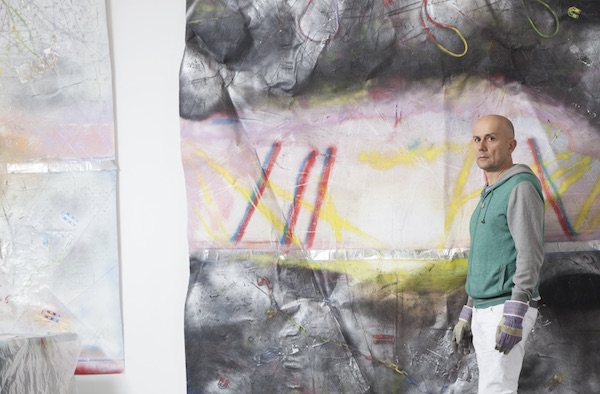
After exploring the possibilities of the human body, Quinn turns to nature.

Hili Perlson

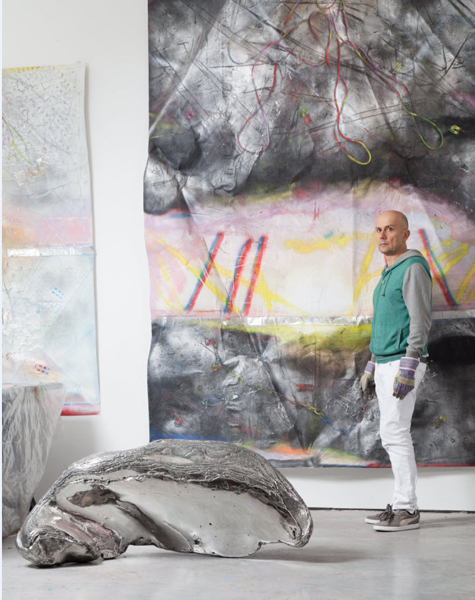
Marc Quinn in his studio.
Photo: Courtesy of Marc Quinn Studio via White Cube.
Marc Quinn doesn’t look far for inspiration. It is delivered to him—like to all of us—in the daily news. Current affairs, new scientific and technological advancements, violence, and war have all been funnelled into his artworks as subject matters, oftentimes filtered through a critical awareness of the spectacle created by the media.
A central figure of the YBAs, Quinn’s relevance at this later stage of his art-making doesn’t seem to wane–he still captivates viewers, inspires critics to pen scathing reviews, and is embraced by collectors.
His piece Alison Lapper Pregnant (2005) adorned the Fourth Plinth of London’s Trafalgar Square and marked the beginning of Quinn’s engagement with questions surrounding beauty and the body. Quinn famously made a series of bronze and gold sculptures of Kate Moss in yoga bends, featured life-size sculptures of the transgender “pregnant man” Thomas Beatie, and of the transsexual porn actors Allanah Starr and Buck Angel as a modern-day Adam and Eve.
Now, he’s focused his observation on nature—meaning both the environment as well as human nature. Quinn’s latest show, “The Toxic Sublime,” on view from July 15 at White Cube Bermondsey, is centered on our complex relationship with our environment. Quinn explores banal questions about our everyday behavior, and our inability to align it with our knowledge of global warming.
Environmental catastrophes caused by global warming feature in the news regularly, yet it’s the strange effect of news media to make us somewhat jaded towards the things we don’t have the immediate power to change. Is this a focus in your new work?
It’s about our relationship to nature and the planet, destroying and creating at the same time. How do you account for that relationship and how do you live it responsibly? I guess it came from looking at a beautiful sunrise, looking at Turner and Caspar David Friedrich and all these people painting the sublime, and kind of realizing that you can’t just paint a picture of a sunrise now, it’s just totally irrelevant. And yet somehow, there’s a reality to that, and I guess you have to see it through the filter of global warming, air travel, all those things.
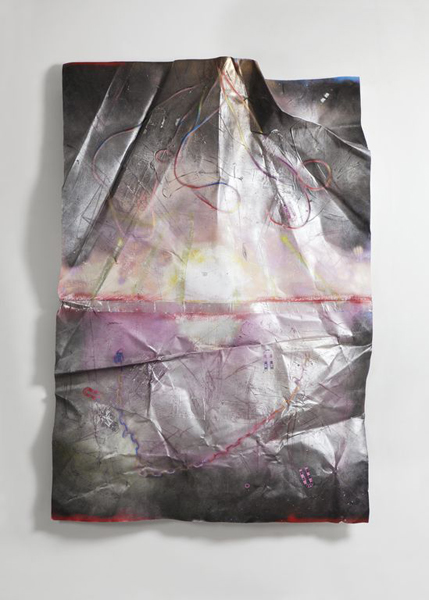
Marc Quinn, The Toxic Sublime – O8@=du5JPnfZx (2015).
Photo: Courtesy of Marc Quinn Studio via White Cube.
And how is this complex relationship represented in the works?
I paint these sunrises in London and then work on the street. So you’re bringing the street into this image of purity. I grind the manhole covers into the picture, so that the sunrise is completely obliterated by the overpainting. Once they’re put on canvas, they’re then stuck on metal, and the metal is twisted up. I was thinking about the Malaysian Airlines crash and the bits of metal on the floor. It somehow struck me, I wanted it to be like the image was imprinted on the metal, like an early photograph, kind of an image of the event imprinted on the metal. They’re quite difficult to photograph, though, that’s the only problem.
So you’re using different ways of imprinting images, like frottage and photography, to create a work that ends up being one layer, one surface. It sounds like a metaphor for the Anthropocene. Man’s doings is imprinted into the Earth’s surface and there’s no separating the organic from the synthetic.
There’s a kind of memory of the landscape there. There’s Thames water, and textures from the street, and then these lines are made with stuff I found on the beach, or maybe spray paint. I’ve got to use the language of the city. So it’s this thing about not sitting in a room all the time, but somehow engaging with the world. Also, I took this picture [of a sunset] in the Caribbean—I flew to the Caribbean, how much greenhouse gas does that account for? And actually, I don’t really take a moral viewpoint, I’m just reflecting the world as it is.
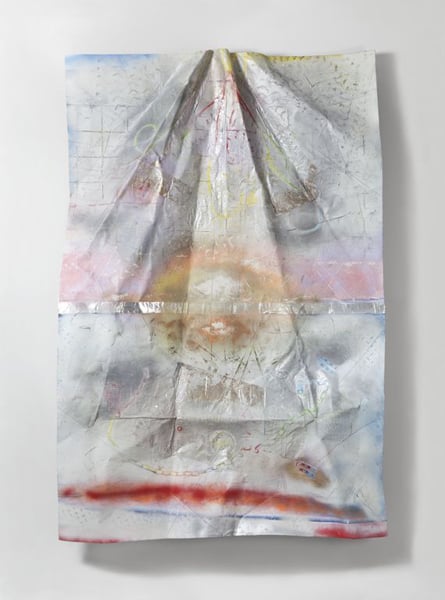
Marc Quinn, The Toxic Sublime – 5$5)^6$3Y7w (2015).
Photo: Courtesy of Marc Quinn Studio via White Cube.
The show also includes sculptures, and from the images, they evoke future archeological artifacts, like finding something out of Terminator hundreds of years from now.
The sculptures are made from these bits of shell. When a shell is eroded, they all kind of end up looking the same, because it’s the thickest part of the shell that remains. It looks like an early thing from a cave sculpture or something. It also usually has a shape that looks a bit like a wave, and that is made by the actual wave. So to me, it’s a counterpoint to the paintings, which are about our relationship to nature; this is a self-portrait of nature itself.
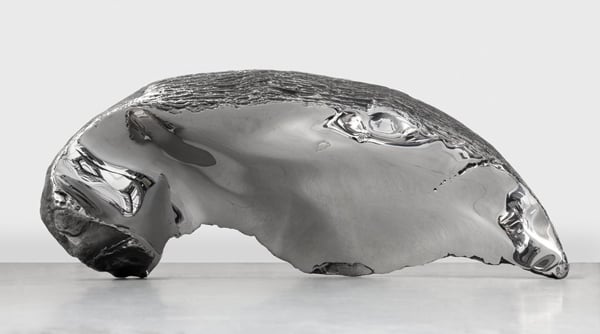
Marc Quinn, Frozen Wave (The Conservation of Linear Momentum) (2015).
Photo: Courtesy of Marc Quinn Studio via White Cube.
How were they made?
They’re scanned with a 3D scanner, and then turned into stainless steel, which is very industrial. So the back of the sculpture is rough, and then when you turn it over, it’s shiny. It’s almost like a sculpture of a wave. In the gallery, they look like sea creatures going, and on the walls there are these paintings, which are like oyster shells, or almost like Chinese landscape paintings, all these layers of eroded shell material.
The shell sculptures range from about human size to the size of a small boat. What kind of a spatial experience are you creating in the exhibition?
When you’re in the room, there’s a human landscape, and also these kind of strange mysterious things from the depths of nature. So hopefully that’s the effect, like whales, I always hear whale music in my head when I’m looking at them. It’s a very simple show, it’s just those two elements, paintings and sculptures. Hopefully they’re related and speak to each other in complicated ways, even though they’re quite simple.
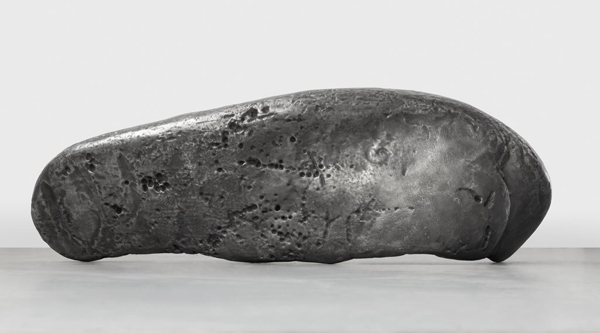
Marc Quinn, Frozen Wave (The Conservation of Culture) (2015).
Photo: Courtesy of Marc Quinn Studio via White Cube.
Throughout your career, your work has tended to react to current affairs and new technologies. Is that a reflection of your understanding of the role of the artist ion society, if there is one?
I hope so. I think as an artist you should reflect the world you live in. I mean, that’s what’s important. What’s interesting is to look at artists who did that in the past, not artists who sat in their own bubble. I think it’s quite interesting to have art that could only be made in one period. Obviously, an artwork could have something universal as well. It is really from a certain period but, hopefully, can transcend that period too. But I think if you have something that’s about the human condition, then it should transcend its time, because the human condition will never change. You might say, “Oh, we’re so digital now, everything’s different,” but we’re the same as when we lived in a cave, I’m sure. Mentally, spiritually, and emotionally. We’re just surrounded by more technology.
Marc Quinn, “The Toxic Sublime,” is on view at White Cube Bermondsey from July 15 – September 13, 2015.